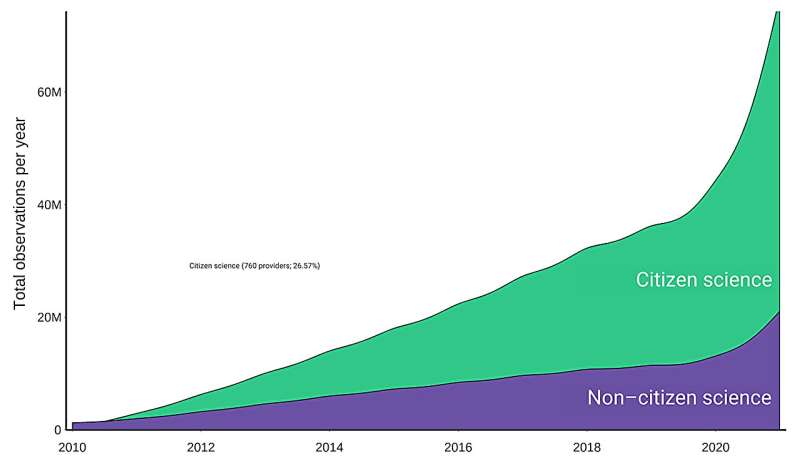This article has been reviewed according to Science X's editorial process and policies. Editors have highlighted the following attributes while ensuring the content's credibility:
fact-checked
trusted source
proofread
Aussies provide more than 62 million species records for conservation research

Citizen scientists have contributed more than half of all species records to Australia's national biodiversity database—the Atlas of Living Australia (ALA)—and play a crucial role in supporting conversation and biodiversity research, a new study has found.
This equates to more than 62 million out of a total of 125 million species records in the ALA, which is hosted by Australia's national science agency, CSIRO.
Dr. Erin Roger, ALA's Citizen Science Lead, said citizen science is the practice of the general public volunteering to engage in science, and offers enormous potential in filling knowledge gaps of many underrepresented species.
"More than 9.6 million new species occurrence records were added to the ALA from citizen scientists in 2022 alone," Dr. Roger said.
"In some cases, citizen science data make up the majority of public data records for species, like the Black Rockcod (Epinephelus daemelii) where 63 percent of all records come from citizen scientists.
"By contributing data records about species found in Australia, we can better reflect the global changes in species distribution and abundance and be more equipped with information to tackle potential extinctions and mitigate biodiversity loss."
All records in the ALA, which aggregates records from more than 850 data providers, feed into the Global Biodiversity Information Facility (GBIF), an international network that provides anyone, anywhere, open access to data about all types of life on Earth.
Through the contributions of citizen scientists feeding into open-access databases like the ALA and GBIF, often this is where incursions of invasive species are first detected.
"Citizen science is a global movement and through improved technologies and the ability to integrate with other datasets to create 'big data,' this will help to solve some of the biggest ecological questions and ultimately deliver better species outcomes," Dr. Roger said.
ALA Director, Dr. Andre Zerger, said birds currently accounted for about 50 percent of all data records, followed by vascular plants at 31 percent, while fungi are one of the lowest represented taxonomic groups at just 1.4 percent of records.
"Currently citizen science practices tend to favor large, brightly colored, charismatic species," Dr. Zerger said.
"Therefore, it's no surprise that birds in city areas are vastly overrepresented in data records while groups like invertebrates, fungi and non-vascular plants or species in remote areas are severely lacking in data.
"There's so much untapped potential for scientific output from open-source data infrastructures like the ALA and around the world.
"Improving how we better target observations to build a truly representative national biodiversity data system is the next frontier."
The paper, "Open Access Research Infrastructures are Critical for Improving the Accessibility and Utility of Citizen Science: A Case Study of Australia's National Biodiversity Infrastructure, the Atlas of Living Australia (ALA)," was published open access in Citizen Science: Theory and Practice.
More information: Erin Roger et al, Open Access Research Infrastructures are Critical for Improving the Accessibility and Utility of Citizen Science: A Case Study of Australia's National Biodiversity Infrastructure, the Atlas of Living Australia (ALA), Citizen Science: Theory and Practice (2023). DOI: 10.5334/cstp.564
Provided by CSIRO

















